Morocco 2015 "Rocks and Fossils of Morocco"
| << previous page | back to index | next page >> |
| Issue Date | 09.10.2015 |
| ID | Michel: 1876-1879; Scott: 1208-1211; Stanley Gibbons: Yvert et Tellier: 1713-1716; Category: pF |
| Design | |
| Stamps in set | 4 |
| Value |
3.75 - Stromatolite 3.75 - Marrellomorph 9.00 - Aegirocassis 9.00 - Tissint_meteorite |
| Size (width x height) | 40 mm x 30 mm; 30 mm x 40 mm |
| Layout | Sheets of 25 stamps |
| Products | FDC x 1 |
| Paper | |
| Perforation | 13 x 13 |
| Print Technique | Offset |
| Printed by | Philaposte France |
| Quantity | |
| Issuing Authority | Barid Al-Maghrib |
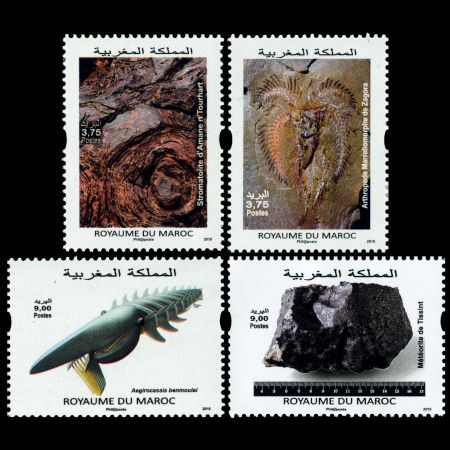
On October 9th, 2015, on the occasion of the international conference "RALI 2015- The Rise of Animal Life", which took place in Marrakesh between October 5 and October 10 2015, organized under the High Patronage of His Majesty King Mohamed VI, the Cadi Ayyad University, under the themes of the Cambrian Explosion and Great biodiversification Cambrian and the Promotion of the Geological Heritage, Barid Al-Maghrib, the Post Authority of Morocco issued the set of 4 stamps "Rocks and Fossils of Morocco".
The formal theme of the meeting is devoted to "Cambrian and Ordovician radiations". In conjunction with the conference, a special symposium dedicated to aspects of Geological Heritage was held and highlighted associated educational, cultural and socio-economic issues. The scientific sessions were followed by a field trip, a “Geotraverse of Central High Atlas and Anti- Atlas. This field trip offered participants the opportunity to visit fossil localities near Zagora, where the Fezouata Biota is currently being studied by an international team of scientists. In the Ternata plain (N. of Zagora), the Lower Ordovician succession (Fezouata Shale and Zini Sandstones) lies unconformably over the middle Cambrian Tabanite Group. The Fezouata Shale corresponds to a thick monotonous series (1000 m) of siltstones deposited under shallow offshore conditions (storm-wave influence). The Fezouata Biota provides a unique insight into one of the most critical periods in the evolution of marine life: the Cambrian-Ordovician transition.
Stromatolites or stromatoliths are layered bio-chemical accretionary structures formed in shallow water by the trapping, binding and cementation of sedimentary grains by biofilms (microbial mats) of microorganisms, especially cyanobacteria.
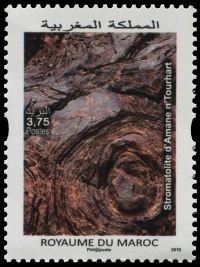 |
| Stromatolite on stamp of Morocco 2015 MiNr.: 1876, Scott: 1208. |
A variety of stromatolite morphologies exists, including conical, stratiform, branching, domal, and columnar types. Stromatolites occur widely in the fossil record of the Precambrian, but are rare today. Very few ancient stromatolites contain fossilized microbes. While features of some stromatolites are suggestive of biological activity, others possess features that are more consistent with abiotic (non-biological) precipitation. Finding reliable ways to distinguish between biologically formed and abiotic stromatolites is an active area of research in geology.
There are only two more stamps and one commemorative postmark depicting stromatolites issued to date:
- definitive set of Angola 1970 (face value 3#00)
- Canada 1990 (green stamp)
- postmark of India 2015
The second stamp shows a Marrellomorph arthropod from Zagora region of Morocco, discovered by Mohamed Benmoulai, local collector and it is the first time when fossilized soft tissue of the species is found which is very rare for arthropods.
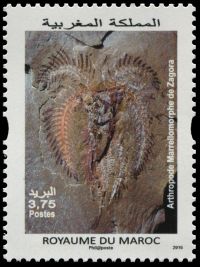 |
| Marrellomorph on stamp of Morocco 2015 MiNr.: 1877, Scott: 1209. |
On March 12, 2015, SciTech Daily website reports about newly discovered fossils of an extinct sea creature named Aegirocassis benmoulae which provides key evidence about the early evolution of arthropods.
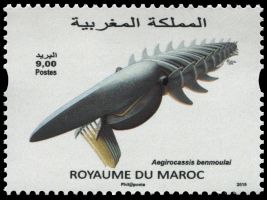 |
| Aegirocassis on stamp of Morocco 2015 MiNr.: 1878, Scott: 1210. |
“Aegirocassis is a truly remarkable looking creature,” said Yale University paleontologist Derek Briggs, co-author of a Nature paper describing the animal.
We were excited to discover that it shows features that have not been observed in older Cambrian anomalocaridids — not one but two sets of swimming flaps along the trunk, representing a stage in the evolution of the two-branched limb, characteristic of modern arthropods such as shrimps.
The recent discovery of Aegirocassis benmoulae bring new details at arthropods story. The new animal shows that anomalocaridids in fact had two separate sets of flaps per segment. The upper flaps were equivalent to the upper limb branch of modern arthropods, while the lower flaps represent modified walking limbs, adapted for swimming.
Furthermore, a re-examination of older anomalocaridids showed that these flaps also were present in other species, but had been overlooked. These findings show that anomalocaridids represent a stage before the fusion of the upper and lower branches into the double-branched limb of modern arthopods.
Aegirocassis benmoulae is also remarkable from an ecological standpoint, note the researchers. While almost all other anomalocaridids were active predators that grabbed their prey with their spiny head limbs, the Moroccan fossil has head appendages that are modified into an intricate filter-feeding apparatus. This means that the animal could harvest plankton from the oceans. “Giant filter-feeding sharks and whales arose at the time of a major plankton radiation, and Aegirocassis represents a much, much older example of this — apparently overarching — trend,” said Dr. Van Roy is one of the authors of a new study that has shed light on the early evolution and development of arthropod limbs.
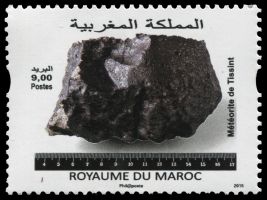 |
| Tissint_meteorite on stamp of Morocco 2015 MiNr.: 1879, Scott: 1211. |
The Tissint meteorite, a piece of Mars that crashed into Earth in July 2011, may contain proof of ancient life on the red planet, according to a new study. The researchers believe organic carbon found within the meteorite is Martian in origin and may have been created by biologic processes. Recent research estimates the Tissint meteorite was ejected from Mars about 700,000 years ago and may have been formed 400 million to 500 million years ago.
Products and associated philatelic items
| FDC | Examples of circulated covers | |
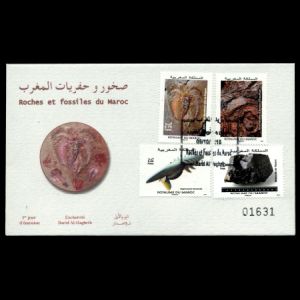 |
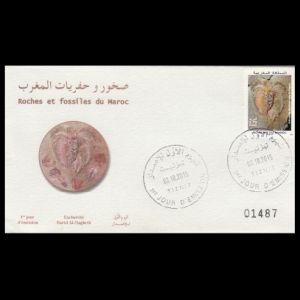 |
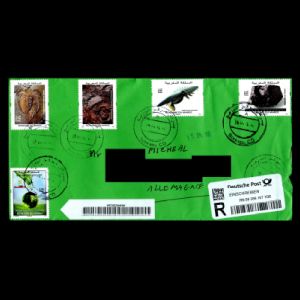 |
| The same cover, but different postmark. | ||

|
References
-
Technical details and short description of the stamps:
Post of Morocco, colnect. -
The International Conference, The Rise of Animal Life, 05-10th October 2015 Marrakesh :
Abstract of The International Conference The Rise of Animal Life RALI2015 -
Stromatolite:
Wikipedia -
Marrellomorpha:
Wikipedia -
Aegirocassis:
Sci Tech Daily Wikipedia -
Tissint Meteorite:
IB Times
Acknowledgements
Many thanks to Dr. Peter Voice from Department of Geological and Environmental Sciences, Western Michigan University, for reviewing the draft page and his valuable comments.| << previous page | back to index | next page >> |